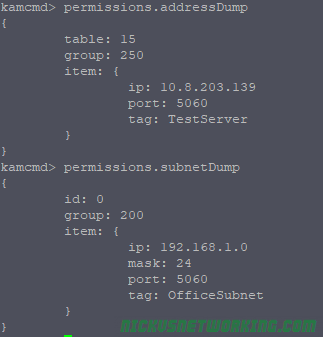Kamailio’s permissions module is simple to use, and we’ve already touched upon it in the security section in our Kamailio 101 series, but I thought I’d go over some of it’s features in more detail.
At it’s core, Kamailio’s Permissions module is a series of Access Control Lists (ACLs) that can be applied to different sections of your config.
We can manage permissions to do with call routing, for example, is that source allowed to route to that destination.
We can manage registration permissions, for example, is this subnet allowed to register this username.
We can manage URI permissions & address permissions to check if a specific SIP URI or source address is allowed to do something.
We’ll touch on a simple IP Address based ACL setup in this post, but you can find more information in the module documentation itself.
The Setup
We’ll be using a database backend for this (MySQL), setup the usual way.
We’ll need to load the permissions module and setup it’s basic parameters, for more info on setting up the database side of things have a look here.
loadmodule "permissions.so"
...
modparam("permissions", "db_url", DBURL)
modparam("permissions", "db_mode", 1)Next we’ll need to add some IPs, we could use Serimis for this, or a straight MySQL INSERT, but we’ll use kamctl to add them. (kamcmd can reload addresses but doesn’t currently have the functionality to add them)
kamctl address add 250 10.8.203.139 32 5060 TestServer
kamctl address add 200 192.168.1.0 24 5060 OfficeSubnet
The above example we added a two new address entries,
The first one added a new entry in group 250 of “10.8.203.139”, with a /32 subnet mask (Single IP), on port 5060 with the label “TestServer”,
The second one we added to group 200 was a subnet of 192.168.1.0 with a /24 subnet mask (255 IPs), on port 5060 with the label “OfficeSubnet”
On startup, or when we manually reload the addressTable, Kamailio grabs all the records and stores them in RAM. This makes lookup super fast, but the tradeoff is you have to load the entries, so changes aren’t immediate.
Let’s use Kamcmd to reload the entries and check their status.
kamcmd permissions.addressReload
kamcmd permissions.addressDump
kamcmd permissions.subnetDump
You should see the single IP in the output of the permissions.addressDump and see the subnet on the subnetDump:

Usage
It’s usage is pretty simple, combined with a simple nested if statement.
if (allow_source_address("200")) {
xlog("Coming from address group 200");
};
if (allow_source_address("250")) {
xlog("Coming from address group 250");
};The above example just outputs to xlog with the address group, but we can expand upon this to give us our ACL service.
if (allow_source_address("200")) {
xlog("Coming from address group 200");
}else if (allow_source_address("250")) {
xlog("Coming from address group 250");
}else{
sl_reply("401", "Address not authorised");
exit;
}If we put this at the top of our Kamailio config we’ll reply with a 401 response to any traffic not in address group 200 or 250.
Hello to you, I am beginner with the Kamailio SIP server, I did not understand well the permissions module, I would like to know being in the same network with another kamailio instance, is it possible to allow the users of this instance to communicate with the users who are registered on my kamailio server through the allow_source_address() function.